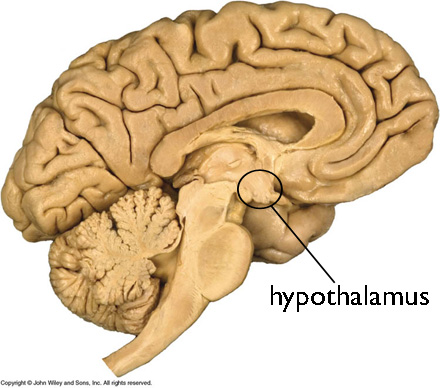Answer: The hypothalamus is subdivided into several distinct subregions anatomically. It functions as the connection between the brain and the rest of the body by acting as an endocrine structure that can release neurotransmitter into the blood, and serves many functions, such as temperature regulation, sleep-wake patterns, hunger, and more.
The hypothalamus is a small brain structure that is part of the diencephalon. Anatomically, it is divided into three regions, anterior, tuberal, and posterior hypothalamus, each of which contain multiple nuclei.
Anterior hypothalamus
The preoptic nucleus of the anterior hypothalamus contains neurons that are responsible for the body's ability to regulate temperature. It receives inputs from the somatosensory system, and sends signals to other hypothalamic structures that lead to wither heat production or heat conservation.
The supraoptic nucleus contains magnocellular secretory cells that produce vasopressin, a hormone that is involved in the regulation of blood water content. Because of its role in water secretion, vasopressin is also called anti-diuretic hormone (ADH).
The medial region of the anterior hypothalamus contains a structure called the suprachiasmatic nucleus, or SCN. The SCN receives inputs from the retinohypothalamic tract, and functions to signal to the pineal gland about circadian rhythm.
Tuberal hypothalamus
The medial portion of the hypothalamus contains the arcuate nucleus. The arcuate nucleus has many different types of neurons that produce a variety of hormones, including the tuberoinfundibular dopamine neurons, which regulates prolactin release.
The lateral hypothalamus is contained here. Within the lateral hypothalamus are cells that produce the neurohormone orexin, and send projections throughout the brain and spinal cord.
Posterior hypothalamus
The posterior hypothalamus contains twin paired structures called the mammillary bodies, which have been seen to degrade in memory-loss disorders like Korsakoff's syndrome. Other adjacent structures contribute to papillary responding and blood pressure regulation.
The lateral portion of posterior hypothalamus contain orexin producing neurons. Orexin serves as an appetite-generating neurosignaling molecule, and also is involved in sleep regulation. Here, there is also the primary source of neuronal histamine production, from a small nuclei of cells in the tuberomammillary nucleus (TMN).
Overall, the hypothalamus receives several inputs and outputs which are responsible for controlling several different homeostasis functions of the body.
